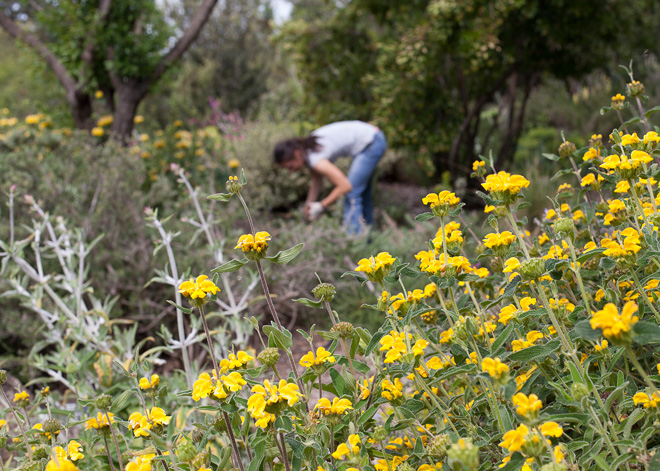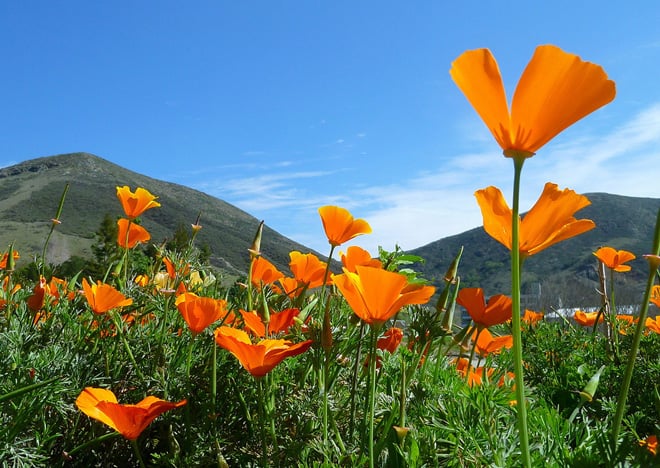

Contributor
- Topics: Archive

[sidebar] Leaning Pine Arboretum
Cal Poly University
San Luis Obispo, CA 93405[/sidebar]
Just a short walk from the busy campus core of California Polytechnic State University, San Luis Obispo (Cal Poly) you will find the University’s best kept secret: the Leaning Pine Arboretum. Part of the Horticulture and Crop Science Department, the Leaning Pine Arboretum is a five-acre living laboratory, whose garden spaces are dedicated to educating students and the general public about the mediterranean climates of the world, as well as the importance of creating and inhabiting landscapes that are in harmony with the places we live.

More than a collection of trees, the Leaning Pine Arboretum is home to many plants, including woody shrubs, annuals, herbaceous perennials, and geophytes. Plants in the collection are arranged, organized, labeled, and accessioned so the Arboretum is properly called a botanic garden. However, the Leaning Pine Arboretum is primarily built for education, namely the education of horticulture students at Cal Poly. The arboretum has evolved over the past four and a half decades, entirely under the care and vision of students, faculty, and staff. Designed and shaped by multiple generations through separate, distinct teaching activities, garden spaces within the arboretum were slowly established over time. Ultimately, the Leaning Pine Arboretum has become a place of learning for the community, a counterpoint to the rapid pace and stress of education and academia, and an inspired public garden.


Plantings at the Leaning Pine Arboretum focus mainly on the five mediterranean climate regions of the world: California, Chile, South Africa, Australia, and the Mediterranean Basin. But as you walk the gardens you will still find a New Zealand collection, a palm collection, a formal garden, a dwarf and unusual conifer collection, and here and there an out of place plant—all vestiges of the garden’s evolution. However, there is also a sense of flow and cohesiveness among the various planting areas. The blending of many diverse projects and ideas over time is not simply a collection of gardens but is one garden. With its own unique sense of place, the Leaning Pine Arboretum is a garden that can be as many things and hold as many meanings as its various user groups, which include students, faculty, families, wildlife lovers, and researchers.

The core of the Leaning Pine Arboretum mission is education, which takes place on many levels. Plantings are labeled and organized into collections, making them useful to students studying for plant materials courses and a resource for home gardeners looking for plants that will perform well in their own landscapes. The plants themselves are a reservoir of information and are often discreetly pruned and taken to other departments where students are learning about botany, taxonomy, or dendrology. A self-guided garden tour highlights individual plants and interesting facts about the garden, and interpretive displays tell the stories of signature plant groups such as the oaks of California and banksias of Australia, and provide information on how to grow them. The garden is also used by many classes not associated with horticulture: English classes reading Walden, recreation classes learning the art of leading team building activities, and many others simply looking for a quiet place to sit and have a class discussion or group activity on the lawn.

From its roots in education, the arboretum has grown into an important space for leisure and relaxation as well. The garden’s main path that leads visitors to each major plant collection is easily walkable in 15 minutes, and the many benches and sitting areas make it a lunchtime destination for numerous faculty and staff who want to get out of their offices and stretch their legs. Whether taking a nap or hanging out with friends, students who use the arboretum say that it is an important place to escape and de-stress from the demands of school, which is increasingly dominated by the tools of technology. “Mommy and Me” groups have found the arboretum and regularly meet on the main lawn, as it is a great place to let kids run free while the parents chat. Birders visit the arboretum to observe the abundance of wildlife—although not at the same time as the visiting “Mommy and Me” groups. And families and friends meet at the arboretum to slow down, enjoy a leisurely stroll, take time to talk, and enjoy each other’s company.

The people who visit the Leaning Pine Arboretum—and their reasons for visiting—are as diverse as the plant collections housed within. Whether visitors are here for education or relaxation or a little of both, if they walk through in ten minutes or sit and study for hours, the Leaning Pine Arboretum is a place to inspire people to be in the world around them.
Regional Landscape Design in Central California
A PHS Changing Times, Changing Landscapes seminar
Join PHS for an inspiring and educational weekend seminar exploring a contemporary approach to garden design—one that reflects local climate zones, smart water use, and harmonious plant choices.
Hub for the weekend is the Cal Poly San Luis Obispo campus and includes a tour of Leaning Pines Arboretum. You’ll also visit gardens designed by seminar speakers, and enjoy an evening together Saturday at one of the area’s outstanding nurseries.
Further details and registration information here.
Share:
Social Media
Garden Futurist Podcast
Most Popular
Videos
Topics
Related Posts

Ground Up Science for Greener Cities with Garden Futurist Dr. Alessandro Ossola
Spring 2023 Listen to the Podcast here. Alessandro Ossola is a scientist who gets very excited about the challenge of climate change allowing for an

Readying Urban Forests for Climate Realities with Garden Futurist Dr. Greg McPherson
Winter 2023 Listen to the Podcast here. “Going from the mow and blow to a more horticulturally knowledgeable approach to maintaining the landscape. And that

Low Maintenance Gardens – Better for Pollinators and People
Autumn 2022 “I come out every day. It’s therapy, my meditation.” Janet’s young garden transformed from overgrown, invasive plants to mostly natives. The dailiness of

Calochortophilia: A Californian’s Love Affair with a Genus
Summer 2022 I can chart the progression of my life by Calochortus. For the last two decades, at least. As a teenage girl growing up










Responses